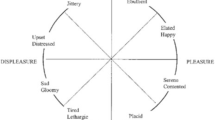Abstract
Two theoretical perspectives concerned with how one emotional state may influence a subsequent one were examined. Zillmann's (1979) excitation transfer theory suggests that undetected residual arousal from a first state will transfer and intensify a subsequent state—regardless of the first state's hedonic valence. Baron's (1977) incompatible response model, on the other hand, suggests that the hedonic valence of an earlier state will affect the experience of a second state and that this effect will be strongest when the two states are temporally close. The results of this investigation support the incompatible response model but not the excitation transfer model. Unrecognized residual arousal from a prior state failed to affect subjects' second emotional state, although the hedonic valence of the prior state did affect the final emotional state when the second state was induced immediately after the first. All emotional states, although they may be equally arousing, do not affect subsequent emotion in an identical manner. When two emotional states are induced in quick succession, the hedonic valence of the prior state plays an important role in determining the intensity of the subsequent emotional state.
Similar content being viewed by others
References
Baron, R. A. (1976). The reduction of human aggression: The inhibiting influence of incompatible reactions.Journal of Applied Social Psychology, 6 260–274.
Baron, R. A. (1977).Human aggression. New York: Plenum Press.
Baron, R. A. (1979). Heightened sexual arousal and physical aggression: An extension to females.Journal of Research in Personality, 13 91–102.
Baron, R. A., & Ball, R. L. (1974). The aggression-inhibiting influence of nonhostile humor.Journal of Experimental Social Psychology, 10 23–33.
Baron, R. A., & Bell, P. (1977). Sexual arousal and aggression by males: Effects of type of erotic stimuli and prior provocation.Journal of Personality and Social Psychology, 35 79–87.
Byrne, D., Fisher, J. D., Lamberth, J., & Mitchell, H. E. (1974). Evaluations of erotica: Facts or feelings?Journal of Personality and Social Psychology, 29 111–116.
Cantor, J. R., Bryant, J., & Zillmann, D. (1974). Enhancement of humor appreciation by transferred excitation.Journal of Personality and Social Psychology, 30 812–821.
Cantor, J. R., Zillmann, D., & Bryant, J. (1975). Enhancement of experienced sexual arousal in response to erotic stimuli through misattribution of unrelated residual excitation.Journal of Personality and Social Psychology, 32 69–75.
Fisher, W. A. (1982). Gender, gender role, and response to erotica. In E. R. Allgeier & N. B. McCormick (Eds.),Gender roles and sexual behavior: Changing boundaries. Palo Alto: Mayfield.
James, W. (1884). What is emotion?Mind, 9 188–204.
Ramirez, J., Bryant, J., & Zillmann, D. (1982). Effects of erotica on retaliatory behavior as a function of level of prior provocation.Journal of Personality and Social Psychology, 43 971–978.
Reisenzein, R. (1983). The Schachter theory of emotion: Two decades later.Psychological Review, 94 239–264.
Sapolsky, B., & Zillmann, D. (1981). The effect of soft-core and hard-core erotica on provoked and unprovoked hostile behavior.Journal of Sex Research, 17 319–343.
Schachter, S., & Singer, J. E. (1962). Cognitive, social and physiological determinants of emotional state.Psychological Review, 69 379–399.
Tannenbaum, P. H., & Zillmann, D. (1975). Emotional arousal in the facilitation of aggression through communication. In L. Berkowitz (Ed.),Advances in experimental social psychology (Vol. 8). New York: Academic Press.
Weiner, B. (1982). The emotional consequences of causal attributions. In M. S. Clark & S. T. Fiske (Eds.),Affect and cognition. Hillsdale, New Jersey: Erlbaum.
White, L. A. (1979). Erotica and aggression: The influence of sexual arousal, positive affect, and negative affect on aggressive behavior.Journal of Personality and Social Psychology, 37 591–601.
Zillmann, D. (1971). Excitation transfer in communication-mediated aggressive behavior.Journal of Experimental Social Psychology, 1 419–434.
Zillmann, D. (1978). Attribution and misattribution of excitatory reactions. In J. Harvey, W. Ickes, & R. F. Kidd (Eds.),New directions in attribution research, (Vol. 2), Hillsdale, New Jersey: Erlbaum.
Zillmann, D. (1979).Hostility and aggression. Hillsdale, New Jersey: Erlbaum.
Zillmann, D., & Bryant, J. (1974). Effect of residual excitation on the emotional response to provocation and delayed aggressive behavior.Journal of Personality and Social Psychology, 30 782–791.
Zillmann, D., Bryant, J., Comisky, P. W., & Medoff, N. J. (1981). Excitation and hedonic valence in the effect of erotica on motivated intermale aggression.European Journal of Social Psychology, 11 233–252.
Zillmann, D., Hoyt, J. L., & Day, K. D. (1974). Strength and duration of the effect of aggressive, violent, and erotic communications on subsequent aggressive behavior.Communication Research, 1 286–306.
Zillmann, D., Johnson, R. C., & Day, K. D. (1974). Attribution of apparent arousal and proficiency of recovery from sympathetic activation affecting excitation transfer to aggressive behavior.Journal of Experimental Social Psychology, 10 503–515.
Zillmann, D., Mody, B., & Cantor, J. R. (1974). Empathic perception of emotional displays in films as a function of hedonic and excitatory state prior to exposure.Journal of Research in Personality, 8 335–349.
Zillmann, D., & Sapolsky, B. (1977). What mediates the effect of mild erotica on annoyance and hostile behavior in males?Journal of Personality and Social Psychology, 35 587–596.
Author information
Authors and Affiliations
Additional information
This article is based on a master's thesis that was completed at the University of Western Ontario, where William A. Fisher provided valuable assistance throughout all phases of the research. Robert A. Baron and Eliot R. Smith offered helpful comments on an earlier draft of the manuscript. Portions of this paper were presented at the meeting of the American Psychological Association in Anaheim, California, August 1983.
Rights and permissions
About this article
Cite this article
Branscombe, N.R. Effects of hedonic valence and physiological arousal on emotion: A comparison of two theoretical perspectives. Motiv Emot 9, 153–169 (1985). https://doi.org/10.1007/BF00991573
Issue Date:
DOI: https://doi.org/10.1007/BF00991573




